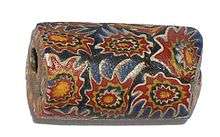Millefiori

Millefiori (Italian: [milleˈfjoːri]) is a glasswork technique which produces distinctive decorative patterns on glassware. The term millefiori is a combination of the Italian words "mille" (thousand) and "fiori" (flowers).[1] Apsley Pellatt in his book Curiosities of Glass Making was the first to use the term "millefiori", which appeared in the Oxford English Dictionary in 1849. The beads were before then called mosaic beads. While the use of this technique long precedes the term "millefiori", it is now most frequently associated with Venetian glassware.
More recently, the millefiori technique has been applied to polymer clay and other materials. As the polymer clay is quite pliable and does not need to be heated and reheated to fuse it, it is a much easier medium in which to produce millefiori patterns than glass.[2]
History
The manufacture of mosaic beads can be traced to Ancient Roman, Phoenician and Alexandrian times. Canes, probably made in Italy, have been found as far away as 8th century archaeological sites in Ireland,[3] and a piece of millefiori was found, along with unworked garnets, in a purse at the early 7th century Anglo-Saxon burial site at Sutton Hoo.

The technical knowledge for creating millefiori was lost by the eighteenth century, and the technique was not revived until the nineteenth century.[4] Within several years of the technique's rediscovery, factories in Italy, France and England were manufacturing millefiori canes.[4] They were often incorporated into fine glass art paperweights.
Until the 15th century, Murano glass makers were only producing drawn Rosetta beads made from molded Rosetta canes. Rosetta beads are made by the layering of a variable number of layers of glass of various colors in a mold, and by pulling the soft glass from both ends until the cane has reached the desired thickness. It is then cut into short segments for further processing.[5]
Production

The millefiori technique involves the production of glass canes or rods, known as murrine, with multicolored patterns which are viewable only from the cut ends of the cane.[5] A murrine rod is heated in a furnace and pulled until thin while still maintaining the cross section's design. It is then cut into beads or discs when cooled.[5]
See also
- Mille-fleur, a French term used to refer to a background composed of small flowers
- Glass museums and galleries
- Venetian beads
References
- ↑ "Millefiori Beads".
- ↑ "Millefiori technique in clay".
- ↑ Susan Youngs (ed), "The Work of Angels", Masterpieces of Celtic Metalwork, 6th-9th centuries AD, 1989, British Museum Press, London, ISBN 0-7141-0554-6
- 1 2 "History of millefiori".
- 1 2 3 "History of the Murano Glass Pendant".
a.jpg)
